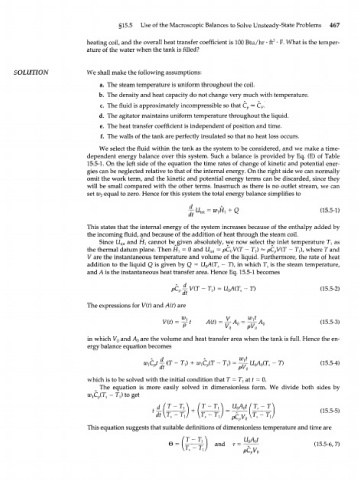Page 487 - Bird R.B. Transport phenomena
P. 487
§15.5 Use of the Macroscopic Balances to Solve Unsteady-State Problems 467
heating coil, and the overall heat transfer coefficient is 100 Btu/hr • ft 2 • F. What is the temper-
ature of the water when the tank is filled?
SOLUTION We shall make the following assumptions:
a. The steam temperature is uniform throughout the coil.
b. The density and heat capacity do not change very much with temperature.
с The fluid is approximately incompressible so that C p ~ C .
v
d. The agitator maintains uniform temperature throughout the liquid.
e. The heat transfer coefficient is independent of position and time.
f. The walls of the tank are perfectly insulated so that no heat loss occurs.
We select the fluid within the tank as the system to be considered, and we make a time-
dependent energy balance over this system. Such a balance is provided by Eq. (E) of Table
15.5-1. On the left side of the equation the time rates of change of kinetic and potential ener-
gies can be neglected relative to that of the internal energy. On the right side we can normally
omit the work term, and the kinetic and potential energy terms can be discarded, since they
will be small compared with the other terms. Inasmuch as there is no outlet stream, we can
set w equal to zero. Hence for this system the total energy balance simplifies to
2
j tf = w,H, + Q (15.5-1)
t tot
This states that the internal energy of the system increases because of the enthalpy added by
the incoming fluid, and because of the addition of heat through the steam coil.
Since (i and H^ cannot be^given absolutely, we now select the inlet temperature 7^ as
tot
the thermal datum plane. Then H = 0 and L7 = pC V(T - TO ~ pC V{T - T ), where T and
} tot v p }
V are the instantaneous temperature and volume of the liquid. Furthermore, the rate of heat
addition to the liquid Q is given by Q = UQA(T - T), in which T is the steam temperature,
S s
and A is the instantaneous heat transfer area. Hence Eq. 15.5-1 becomes
C j V(T - TO = UoA(T, - T) (15.5-2)
P p
The expressions for V(t) and A(t) are
V(t) = ^ t A(t) = — A o = —jj- A o (15.5-3)
-
in which V and A are the volume and heat transfer area when the tank is full. Hence the en-
o o
ergy balance equation becomes
w t t j-AT- TO + w,C (T -T0 = ^r UoA (T, - T) (15.5-4)
Q
p
x p
h y
at pv 0
which is to be solved with the initial condition that T = T at t = 0.
}
The equation is more easily solved in dimensionless form. We divide both sides by
w,C (T - T,) to get
p s
(15.5-5)
This equation suggests that suitable definitions of dimensionless temperature and time are
and x = ^ (15.5-6,7)
pC p V 0

